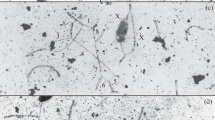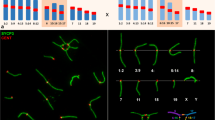Abstract
Metaphase I orientation of centric fusion trivalents was studied in 24 single, 19 double and 3 triple heterozygotes of Dichroplus pratensis. Different populations of this South American melanopline grasshopper are polymorphic for seven Robertsonian fusions, and the polymorphisms seem to be stable. Several cytogenetic factors involved in the orientation and segregation of the meiotic configurations such as chromosomal length, symmetry and number and position of chiasmata, have been analysed in previous works. In this paper we study another factor that is relevant in the above respect in individuals with more than one heterozygous fusion: interaction among configurations regarding orientation.
Our results indicate that, when there are two or three trivalents present in the MI cell, there is an interaction in such a way that the number of metaphases in which the two or three trivalents are non-disjunctionally oriented is always significantly higher than expected under a hypothesis of independence. However, the number of cells in which all trivalents are disjunctionally oriented does not decrease significantly, so an increase of unbalanced gametes due to this factor is not expected. The stability of the polymorphisms would thus not be affected.
Similar content being viewed by others
Refences
Arundhati, A., P.S.R.L., Narasinga Rao & J., Sybenga, 1986. Possible causes of variation in trivalent orientation frequencies in pearl millet and rye. Genetica 70: 81–87.
Baker, R.J. & J.W., Bickham, 1986. Speciation by monobrachial centric fusions. Proc. Natl. Acad. Sci. USA 83: 8245–8248.
Bennett, M.D., 1983. The spatial distribution of chromosomes. pp. 71–79 in Kew Chromosome Conf. II, edited by P.E., Brandham and M.D., Bennett. Allen & Unwin, London.
Bennett, M.D., J.B., Smith, S., Simpson & B., Wells, 1979. Intranuclear fibrillar material in cereal pollen mother cells. Chromosoma 71: 289–332.
Bidau, C.J., 1989. Zonas hibridas en ortopteros: el ejomplo de Dichroplus pratensis (Acrididae), pp. 109–124 in Proceedings I Congreso Argentino de Entomología, Tucumán, edited by Sociedad Argentina de Entomología.
Bidau, C.J., 1990. The complex Robertsonian system of Dichroplus pratensis (Melanoplinae, Acrididae). II. Effects of the fusion polymorphisms on chiasma frequency and distribution. Heredity 64: 145–159.
Bidau, C.J., 1991. Multivalents resulting from monobrachial homologies within a hybrid zone in Dichroplus pratensis (Acrididae): meiotic orientation and segregation. Heredity 66: 219–232.
Bidau, C.J., 1993. Causes of chiasma repatterning due to centric fusions. Brazil. J. Genet. 16(2): 283–296.
Bidau, C.J. & P.M., Mirol, 1988. Orientation and segregation of Robertsonian trivalents in Dichroplus pratensis (Melanoplinae, Acrididae). Genome 30: 947–955.
Bidau, C.J., C., Belinco, P.M., Mirol & D.S., Tosto, 1991. The complex Robertsonian system of Dichroplus pratensis (Melanoplinae, Acrididae). I. Geoghraphic distribution of fusion polymorphisms. Genetique, Selection, Evolution 23: 353–370.
Bruére, A.N., I.S., Scott & L.M., Henderson, 1981. Aneuploid spermatocyte frequency in domestic sheep heterozygous for three Robertsonian translocations. J. Reprod. Fert. 63: 61–66.
Capanna, E., 1982. Robertsonian numerical variation in animal speciation: Mus musculus,an emblematic model. pp. 155–177 in Mechanisms of Speciation, edited by C., Barigozzi, Alan R. Liss, New York.
Church, K., 1977. Chromosome ends and the nuclear envelope at premeiotic interphase in the male grasshopper Brachystola magna by 3-D E.M. reconstruction. Chromosoma 64: 143–154.
Church, K. & P.B., Moens, 1976. Centromere behavior during interphase and meiotic prophase in Allium fistulosum from 3-D, E.M. reconstruction. Chromosoma 56: 249–263.
Colombo, P.C., 1987. Effect of centric fusions on chiasma frequency and position in Leptysma argentina. I. Sponteneous and stable polymorphic centric fusions. Genetica 72: 171–179.
Del, Fosse, F.E. & K., Church, 1981. Presynaptic chromosome behavior in Lillium. I. Centromere orientation and movement during premeiotic interphase in Lillium speciosum cv. Rosemede. Chromosoma 81: 701–716.
Pussell, C.P., 1987. The Rabl orientation: a prelude to synapsis, pp. 275–299 in Meiosis, edited by P.B., Moens. Academic Press, Orlando, FL.
Hewitt, G.M., 1979. Orthoptera, pp. 1–170 in Animal Cytogenetics 3. Insecta 1, edited by B., John. Gebrüder Borntraeger, Berlin-Stuttgart.
John, B., 1981. Chromosome change and evolutionary change: a critique, pp. 23–51 in Evolution and Speciation, edited by W.R., Atchley and D.S., Woodruff. Cambridge Univ. Press, Cambridge.
John, B., 1983. The role of chromosome change in the evolution of orthopteroid insects, pp. 1–110 in Chromosomes in the Evolution of Eukaryotes, Vol. 1, edited by A.K., Sharma and A.S., Sharma. CRC Press, Boca Raton.
John, B., 1987. The orientation behavior of multiple chromosome configurations in Acridid grasshoppers. Genome 29: 292–308.
John, B., 1990. Meiosis. The University Press, Cambridge.
King, M., 1987. Chromosomal rearrangements, speciation and the theoretical approach. Heredity 59: 1–6.
King, M., 1993. Species Evolution. The Role of Chromosome Change. The University Press, Cambridge.
Lande, R., 1979. Effective deme size during long-term evolution estimated from rates of chromosomal rearrangements. Evolution 33(1): 234–251.
Loidl, J., 1990. The initiation of meiotic chromosome pairing: the cytological view. Genome 33: 759–778.
López-Fernández, C., J.S., Rufas, C., García de la Vega & J., Gosálvez, 1984. Cytogenetic studies on Chorthippus jucundus (Fisch.). (Orthoptera). III. The meiotic consequences of a spontaneous centric fusion. Genetica 63: 3–7.
Mirol, P.M. & C.J., Bidau, 1991. Meiotic behavior of Robertsonian heterozygotes in populations of Dichroplus pratensis (Acrididae) with different fusion frequencies. Genetica 84: 171–178.
Mirol, P.M. & C.J., Bidau, 1992. Proximal chiasmata induce non-disjunctional orientation of Robertsonian trivalents in a grasshopper. Heredity 69: 268–278.
Moens, P.B., 1969. The fine structure of meiotic chromosome polarization and pairing in Locusta migratoria spermatocytes. Chromosoma 28: 1–25
Narasinga Rao, P.S.R.L. & J., Sybenga, 1984. Linear orientation of trivalents and quadrivalents in late metaphase I pollen mother cells of pearl millet. Can. J. Genet. Cytol. 26: 506–510.
Rabl, C., 1885. Über Zelltheitung. Morphol. Jahrb. 10: 214–330.
Redi, C. & E., Capanna, 1988. Robertsonian heterozygotes in the house mouse and the fate of their germ cells pp. 315–359 in The Cytogenetics of Mammalian Autosomal Rearrangements, edited by A., Danlel. Alan R. Liss, New York.
Rickards, G.K., 1977. Prometaphase I and anaphase I in an interchange heterozygote of Allium triquetrum (Liliacene). Chromosoma 64: 1–23.
Rickards, G.K., 1983. Orientation behavior of chromosome multiples of interchange (reciprocal translocation) heterozygotes. Ann. Rev. Genet. 17: 443–498.
Searle, J.B., 1986. Factors responsible for a karyotypic polymorphism in the common shrew, Sorex araneus. Proc. R. Soc. London B. 229: 277–298.
Searle, J.B., 1988. Selection and Robertsonian variation in nature: the case of the common shrew, pp. 507–531 in The Cytogenetics of Mammalian Autosomal Rearrangements, edited by A., Daniel. Alan R. Liss, New York.
Sites, J.W. & C., Moritz, 1987. Chromosomal evolution and speciation revisited. Syst. Zool. 36(2): 153–174.
Sybenga, J., 1975. Meiotic Configurations. Springer-Verlag, Berlin/Heidelberg/New York.
Sybenga, J. & G.K., Rickards, 1987. The orientation of multivalents at meiotic metaphase I: a workshop report. Genome 29: 612–620.
Teoh, S.B. & M.S., Yong, 1983. A spontaneous fusion heterozygote in the tropical grasshopper, Valanga nigricornis (Burmeister). Caryologia 36: 165–173.
Tosto, D.S. & C.J., Bidau, 1991. Distribution of chromosome frequencies within a hybrid zone of Dichroplus pratensis (Melanoplinae, Acrididae). Heredity 67: 299–306.
White, B.J., C., Crandall, E.S., Raveché & J.H., Tjio, 1978. Laboratory mice carrying three pairs of Robertsonian translocations: establishment of a strain and analysis of melotic segregation. Cytogenet. Cell Genet. 21: 113–138.
White, B.J., J.H., Tjio, L.C.Van de, Water & C., Crandall, 1972. Studies of mice with a balanced complement of 36 chromosomes derived from F1 hybrids of T1Wh and T1Ald translocation homozygotes. Proc. Natl. Acad. Sci. USA 69: 2757–2761.
White, M.J.D., 1978. Modes of Speciation. W.H. Freeman, San Francisco.
Author information
Authors and Affiliations
Additional information
Both authors are affiliated with the CONICET (Argentina)
Rights and permissions
About this article
Cite this article
Mirol, P.M., Bidau, C.J. Non-random patterns of non-disjunctional orientation in trivalents of multiple Robertsonian heterozygotes of Dichroplus pratensis (Acrididae). Genetica 92, 155–164 (1994). https://doi.org/10.1007/BF00132534
Received:
Accepted:
Issue Date:
DOI: https://doi.org/10.1007/BF00132534




